Documerica
Air Date: Week of April 30, 2010
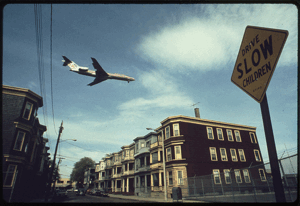 |
Forty years ago, the newly-formed EPA sent photographers all over the country to document America’s environmental problems and its natural beauty. What they came back with is a remarkable picture of America in the early 1970s. Host Jeff Young talks with National Archives curator Bruce Bustard and joins photographer Michael Manhein as he returns to the site he photographed decades ago for the project.
Transcript
YOUNG: The US Environmental Protection Agency turns 40 this year, and one of EPA’s earliest and most creative projects was called Documerica. Hundreds of photographers set out to document the nation’s environment. They produced a striking portrait of America in the midst of an environmental awakening in the early ‘70s.
Now if you’re near a computer, you might want to go to our website, loe dot org, and look at some of these photos as we hear about them from Bruce Bustard. Mr. Bustard is a senior curator at the National Archives and he’s a fan of Documerica.
BUSTARD: I think it really was the brainchild of one man. His name was Gifford Hampshire. And Gifford Hampshire had been exposed to the Farm Security Administration photographs of the 1930’s and early 1940’s. And he fell in love with these photographs, and he got it in his head that he wanted to someday do a documentary photography project.
And when he became part of the brand new Environmental Protection Agency he decided to push the idea again and he discussed it with EPA administrator, William Ruckelshaus. And Ruckelshaus thought it was a great idea and told him to go ahead and set up the project and he ended up running the project.
YOUNG: And what were the goals here, what were they trying to do with this project?
BUSTARD: Well, the mission statement said that it was going to take photographs of environmental concern. And that sounds a bit dry like there would be a lot of photographs of smog and a lot of photographs of dead fish and sewage going into rivers and things like that.
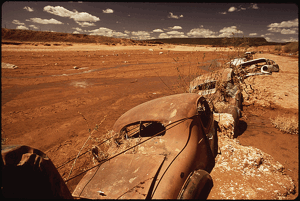
Old cars serve as water-break on Navajo Reservation. (Photo: Terry Eiler, US National Archives)
And certainly there are many, many photographs like that, but Gifford Hampshire had a rather broad idea of the environment. He followed the environmentalist Barry Commoner’s first law of ecology, which was that everything was connected to everything else and if you take that as your sort of credo, then you not only have photographs of smog and air and water pollution, but you also have a photography project that took photographs of a Hispanic ward in El Paso, and of native American reservations. It could be a photograph of great scenic beauty. So it’s a very broad range of topics.
YOUNG: He really did tap into some amazing talent here and there are amazing images. Do you have a particular favorite you want to talk about?
BUSTARD: Well, one photograph that I’m particularly fond of is a photograph that was taken during the first fuel crisis that the nation went through in the early 1970s. The photographer is a man by the name of David Falconer, and he took this wonderful photograph of a gas station that had been abandoned because of the fuel crisis and a religious organization took over the gas station.
And they painted a gigantic “Jesus Saves” sign on the actual gas station. And then they also painted the fuel pumps in bright red and purple, and the photograph shows in the foreground, the gas pumps, one is painted and it says, “Fill up with the holy ghost and fire.”
And then the other pump has an image of Jesus on it, and it says, “Fill up with old time salvation.” And so this is one of my favorites just because it’s such an imaginative composition I think and it shows again where a really creative photographer could go with an assignment to photograph the fuel crisis.
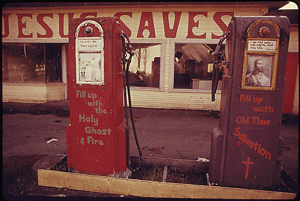
Gasoline stations abandoned during the fuel crisis in the winter of 1973-74 were sometimes repurposed. This station was turned into a religious meeting hall. (David Falconer, US National Archives.)
YOUNG: There’s another one in here I’m very fond of and it is some guys waiting for a black lung screening program.
BUSTARD: Yes, this is a photograph that was taken by a photographer by the name of Jack Corn. And his assignment was to look at life in the coal mining regions of West Virginia and Tennessee, and the effect of a poor environmental condition on the people who live there.
And so this photograph shows a group of five miners and they’re sitting in a hospital waiting room and they’re all about somewhere in their middle age, or perhaps a little bit older, and they are bare-chested, but they have their shirts are draped over them. And they’re just waiting and at least in my mind they look a bit anxious to find out whether they had any kind of problem with black lung.
YOUNG: You know, EPA, this is probably an unfair statement to a degree, but they seem to us today such a faceless bureaucracy, and yet, here is the human element of their work coming through, through these photographs. And that’s really striking to me that that to someone in the early days of this agency, anyway, is what they thought their mission should be about.
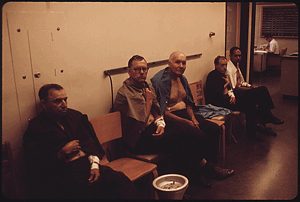
Miners at the Appalachian Regional Hospital in Beckley, West Virginia, wait for tests to determine if they have black lung disease (Photo: Jack Corn, US National Archives)
BUSTARD: I think it reflects some of the early energy in the EPA when it was first created and also reflects some of the idealism of the early environmental movement. Gifford Hampshire knew that he was kind of riding a tide of interest in the environment and he kind of seized the moment and the result were these wonderful photographs.
YOUNG: He also had the foresight to realize that a lot of the environmental issues were about cities and how people lived in the urban environment, and there’s an interesting photograph here of a, looks like plane flying very low over some row houses. Tell me about that one.
BUSTARD: This is a photograph taken by Michael Phillip Manheim, and as you said, there’s a plane that is flying low over the area that is around Logan airport, Neptune road is where most of the photographs were taken. It’s taken at a very low angle, which sort of accentuates the nearness of the plane to the houses.

Homes near Neptune Road directly on the flight path into Boston’s Logan airport. (Photo: Michael Philip Manheim, U.S. National Archives)
There’s also an interesting sign in the foreground of the photograph that says, “Drive slow, children,” which lends a certain amount of irony and context to the photograph. But Manheim was trying to document something that’s kind of difficult I think in a photograph, he was trying to document noise pollution.
YOUNG: National Archives senior curator Bruce Bustard telling us about Documerica.
[PLANE FLIES OVERHEAD]
YOUNG: Planes still roar over Neptune Road today. We went there with Documerica alumnus Michael Manheim. He photographed the Boston neighborhood in 1973. But it’s changed so much; Mr. Manheim had trouble even finding it.
MANHEIM: None of this is familiar.
YOUNG: Hmm. Do we have to walk across the tracks here?
MANHEIM: It should be there, I think.
YOUNG: Ok.
MANHEIM: The remains of Neptune Road. Let me go take a look around. Wow.
YOUNG: The last time Manheim was here, Neptune Road was lined with houses. Now airport parking lots and a runway have replaced the bustling community his lens captured in the ‘70’s.
MANHEIM: Yup, here we are.
YOUNG: This is where you used to be taking pictures of houses?
MANHEIM: Yes. There’s nothing here. And this was the street of the iconic triple-deckers. It was where people from Boston came in the summertime to get the breezes. I don’t know where the beach is now, but there’s a beach just nearby, Constitution Beach, that I photographed. And this was the—just a nice place to take a break from the city. It was one of those beauty spots.
YOUNG: Must have been tough for people who were well established in the neighborhood to see it going through those changes around the time that you were working here.
MANHEIM: One of my photographs is of a man holding up pictures of his kids playing in a park that became an airport runway. And one of the old-timers, of course, they knew what it was like. And there was no spotting this.
[PLANE FLIES OVERHEAD]
MANHEIM: So, yeah, you can hear how terrible it would be to live here. And essentially they were driven out.
YOUNG: If not just the airplanes, it’s the train, it’s the traffic, it’s just an impressive audio environment.
MANHEIM: So, it’s a wonderful place for people not to live, but it used to be bucolic.
YOUNG: You know, they could have documented this other ways, and today we’re accustomed to an environmental measurement is in the form of some charts and graphs and whatnot. Why photography? What made photography seem like a good tool for the EPA to document our environment?
MANHEIM: I don’t know. There’s always the power of the photograph. If you can catch the epitomizing moment, you’ve really spelled it out for people. You have something they can study and think about it, it’s not just flicking by—focus on that image. If it arrests you, it has an emotional impact.
YOUNG: Also, it strikes me that there are people in those photographs, and if you get a chart or a graph, there’s no people there. It’s a reminder that in the end these environmental trends, they’re about people—they’re about us!
MANHEIM: So in the photographs you find the humanity, it’s true.
YOUNG: One of Gifford Hampshire’s goals for Documerica was to record change over time. But the EPA cut the project’s funding after just a couple of years. So we asked Michael Manheim to follow up on his assignment from the ‘70s and document Neptune Road as it is today.
M: Let’s do it. I don’t know where. I used to have subject matter.
YOUNG: Now we have vacant lots.
MANHEIM: Yeah…
YOUNG: We stood among the broken bottles and cracked concrete on a footbridge over the commuter rail—a remnant from the days when there were still homes to get to across the tracks on Neptune road. Manheim snapped shots of security walls and airport delivery trucks splashing through puddles.
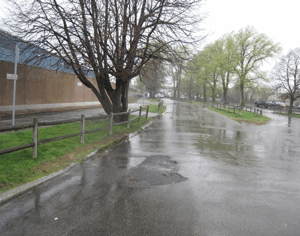
Neptune Road today. (Photo: Michael Philip Manheim)
MANHEIM: And this is how we start telling a story with the camera, we just keep walking and looking...
[PLANE AND TRAIN PASSING]
YOUNG: You can see the photos from Michael Manheim’s return to Neptune Road and check out the rest of the Documerica collection, at our website, loe dot org.
[SFX PLANE, TRAIN FADES]
Links
To see more pictures of Neptune Road in the 1970s, click here.
Check out the rest of the photos in the Documerica collection.
Living on Earth wants to hear from you!
Living on Earth
62 Calef Highway, Suite 212
Lee, NH 03861
Telephone: 617-287-4121
E-mail: comments@loe.org
Newsletter [Click here]
Donate to Living on Earth!
Living on Earth is an independent media program and relies entirely on contributions from listeners and institutions supporting public service. Please donate now to preserve an independent environmental voice.
NewsletterLiving on Earth offers a weekly delivery of the show's rundown to your mailbox. Sign up for our newsletter today!
 Sailors For The Sea: Be the change you want to sea.
Sailors For The Sea: Be the change you want to sea.
 The Grantham Foundation for the Protection of the Environment: Committed to protecting and improving the health of the global environment.
The Grantham Foundation for the Protection of the Environment: Committed to protecting and improving the health of the global environment.
 Contribute to Living on Earth and receive, as our gift to you, an archival print of one of Mark Seth Lender's extraordinary wildlife photographs. Follow the link to see Mark's current collection of photographs.
Contribute to Living on Earth and receive, as our gift to you, an archival print of one of Mark Seth Lender's extraordinary wildlife photographs. Follow the link to see Mark's current collection of photographs.
 Buy a signed copy of Mark Seth Lender's book Smeagull the Seagull & support Living on Earth
Buy a signed copy of Mark Seth Lender's book Smeagull the Seagull & support Living on Earth

